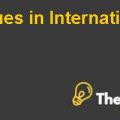
Institutional Situation of India
The five factors which have been used to analyze the institutional situation in India as compared to UK are Ethics and Corruption, Undue Influence, Government efficiency, Security and Corporate Ethics. The values assigned to these factors range from 1 to 7 with the increasing the number showing the improvement in the situation. The situation in India is not good as all the factors have values below 4 compared to the United Kingdom where the situation is much better and the values are above 5 for each factor.
The corruption involves bribing the officials and others to get a work done. This element would increase the costs of the company as they may have to spend millions in bribes for expanding their operations. Security is another factor which would cause Tesco to lose its assets if they get stolen .Moreover, the management heads may be threatened to be killed if they deny paying money to the mafia. The Undue influence of powerful people may halt their smooth operations. For instance, they may be asked to appoint non-competent individuals just because they belong to influential families.
Due to lax rules and regulations, the corporate ethics of companies in India has never been good. This may benefit the company as they may reduce their costs by unethical practices such as child labor. However, as a global company, it may affect their reputation. The bureaucracy may further add to the costs as complex rules and regulations should be complied by Tesco.
Indian vs British Consumers
Power distance figures clearly shows that there is unequal distribution of wealth in India. On the other side, the income seems to be distributed equally.Therefore, Tesco should target wealthy people by providing high quality of staples, processed food and apparel with excellent customer service. There is a strong presence of family culture in the country while consumers in UK are self-dependent. Therefore,Tesco can promote the use of hygienic food which is beneficial for the well-being of a family.
The society of India is driven by competition, achievement and success like UK. With respect to this factor, the company should emphasize its brand image of being a leading brand and only leaders use the brand. It will create a sense of achievement amongst Indian consumers whenever they use Tesco brand.
India is traditionally a patient country where tolerance for the unexpected is high unlike UK where people usually plan for their future. In India, they are bound by social norms and values which shape their attitudes. Therefore, Tesco will have to consider the taste in every state and sell products according to their requirement. There should be a focus on selling vegetables because vegetarians comprise of 30% of the Indian population.
Institutional Changes in India
The government has allowed 51% FDIin Multi-brand retail which has allowed Tesco to enter the Indian market with its number of brands such as general merchandise, fresh foods, processed foods, staples and apparel. Moreover, the exposure to foreign goods in India is rising due to which the retail food sector was developing and increasing by 10% per annum.
This has benefited Tesco in terms of increased profits as it set up its sourcing office in India in 2008. By 2012, Tesco was buying 7% of its global inventory from India. As a result, the group’s supply chain costs had decreased. On the other side, it had another source of revenue by developing a franchise relationship with Trent Hypermarkets whom it advised to improve the shopping experience of consumers.
The industry was becoming competitive with competitors like Reliance Fresh and More. In order to counter them, Tesco, will have to increase its geographical reach and may open stores in many cities as possible. Moreover, Indian shoppers are used to buying groceries as frequently as possible. Therefore,they should change their model and arrange groceries on weekly basis so that the demands for customers in India can be satisfied.Tesco Case Solution
Barriers to Entry
There are many barriers to entry for Tesco to enter the Indian market. These factors are as follows:
- Tesco had to take clearance from the Foreign Investments Promotion Board (FIBP) of the Indian federal government. The clearance was necessary if Tesco wanted to operate in India with more than one brand. In December 2012, the government of India allowed 51% FDI in multi-brand retail.
Tesco is required to invest 50% of its capital in back-end infrastructure. It would mean that $ 55 million will be invested for this purpose. This money could be effectively used if allowed to invest in market development.............
This is just a sample partial case solution. Please place the order on the website to order your own originally done case solution.













